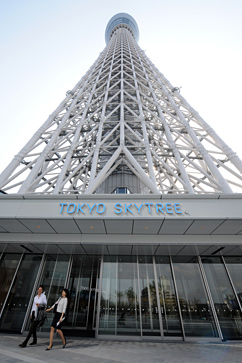Japan Unveils World's Tallest Freestanding Broadcast Structure

(Image Credit: Credit: Toru Yamanaka/AFP/Getty Images)
At 2,080 feet, the Tokyo Sky Tree is the world's tallest freestanding broadcast structure, and stands just 640 feet shy of the world's tallest building, the Burj Khalifa in Dubai.
When it opens its doors to the public next month, the Tokyo Sky Tree will replace the older Tokyo Tower as the tallest landmark in the Japanese capital, and the structure is being hailed as a symbol of a new era in Japan. The tower will bolster television and radio transmissions around the city and the complex will include 312 stores and restaurants, including three eateries on its observation decks.
On Tuesday, journalists were given a sneak peak of the structure.
Aboard a high-speed elevator, it took about 50 seconds to reach the lower observation deck on the 350th floor, 1,148 feet above ground, and another 30 seconds to reach the higher deck on floor 450, which is at 1,476 feet. Visitors were given a heart-stopping look straight down, through a glass floor.
Construction for the $800 million structure began in 2008, but was delayed two months after the catastrophic earthquake and tsunami in March 2011.
A spokesman for Tobu Tower Sky Tree Company, which operates the site, says the tower was constructed to withstand a magnitude 7 quake. When a massive earthquake hit Japan in March of last year, the tower withstood the impact, a spokesman said. Drawing on traditional architecture, the Sky Tree features a central column, like those used in Japanese pagodas. That feature also acts as a pendulum that counterbalances seismic waves, largely reducing the building's overall motion.
"This tower is 'all Japan,' an accumulation of Japanese technology," spokesman Hirotake Takanashi told the Associated Press. "It's the latest technology, but I think it's more the accumulation of Japanese craftsmanship. Around 580,000 people were involved in making this tower."
The Associated Press contributed to this report.